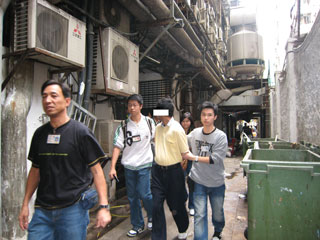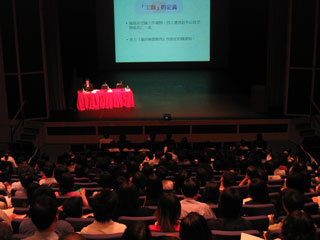Anuual Report 2006
Chapter 6
Employees' Rights and Benefits
The Programme of Employees' Rights and Benefits
www.labour.gov.hk/eng/erb/content.htmThe objective of the Employees' Rights and Benefits Programme is to improve and safeguard employees' rights and benefits in an equitable manner. Our aim is to progressively enhance employment standards in a way which is commensurate with the pace of Hong Kong's economic and social developments and which strikes a reasonable balance between the interests of employers and employees. We achieve this by:
- setting and refining employment standards in consultation with the Labour Advisory Board;
- ensuring compliance with statutory and contractual terms and conditions of employment through inspection to workplaces, investigation into suspected breaches of the statutory provisions and prosecution of offenders;
- processing employees' compensation claims;
- maintaining close partnership with statutory bodies set up for protecting the rights and benefits of employees; and
- providing customer-oriented information service to ensure that employees and employers know their rights and obligations.
The principal legislation administered by this programme area includes the Employees' Compensation Ordinance (ECO), the Pneumoconiosis (Compensation) Ordinance (PCO), the Employment Ordinance (EO) and its subsidiary Employment of Children Regulations and Employment of Young Persons (Industry) Regulations, as well as Part IVB of the Immigration Ordinance.
The ECO establishes a no-fault, non-contributory employee compensation system under which individual employers are liable to pay compensation for work-related injuries or fatalities. The ordinance requires all employers to possess valid insurance policies to cover their liabilities under the ordinance and at common law.
The PCO provides compensation to persons who suffer from pneumoconiosis. Compensation is paid from the Pneumoconiosis Compensation Fund, which is administered by the Pneumoconiosis Compensation Fund Board.
The EO is the main piece of legislation governing conditions of employment in the non-government sector. The Employment of Children Regulations made under the EO prohibit the employment of children below the age of 15 in industrial undertakings and regulate the employment of children who have attained the age of 13 but under 15 in non-industrial establishments. The Employment of Young Persons (Industry) Regulations set out requirements on the working time arrangements for young persons employed in the industrial sector and prohibit their employment in dangerous trades.
The Labour Department also administers Part IVB of the Immigration Ordinance to combat illegal employment in order to protect the employment opportunities of local workers.
Our Work and Achievements in 2006
Key Indicators of Work
We stepped up our efforts to safeguard the rights and benefits of employees through various activities in 2006. Some key indicators of work of this programme area are shown in Figure 6.1.
Stepping Up Enforcement Against Wage Offences
The department takes a serious view on wage default and has put in place effective arrangements to enforce statutory provisions governing payment of wages. In 2006, the department continued to step up prosecution against employers and responsible persons of companies for wage offences. We conducted territory-wide blitz operations and inspections to workplaces to detect wage offences. Labour inspectors actively interviewed employees during territory-wide routine inspections to combat wage offences and conducted investigation speedily into the suspected offences. The Employment Claims Investigation Division also conducted in-depth investigation into suspected wage offences under the EO promptly. Prosecutions are taken out against the employers and the responsible persons once sufficient evidence is available.
With the department continuing in stepping up enforcement action in 2006, the number of summonses heard in respect of wage offences rose to 1 043, representing an increase of 14.9 per cent over the figure of 908 summonses in 2005. As for summonses convicted, the number was 785 for 2006 as against 587 in 2005, an increase of 33.7 per cent. Two company directors and one other employer were given custodial sentences in 2006 for defaulting wage payments. On the other hand, an employer was fined $114,000. These sentences should have sent a strong message to employers on the seriousness of wage defaults.
Vigorous Enforcement Against Illegal Employment
We continued our vigorous enforcement efforts to ensure that the statutory rights of employees under labour legislation are well protected.
In 2006, labour inspectors carried out 128 590 workplace inspections to establishments in different trades, among which 127 871 inspections were also conducted to combat illegal employment. (Figure 6.2) We strengthened the collection and analysis of intelligence on illegal employment activities, and organised more joint operations with the Police and the Immigration Department. A total of 502 illegal workers and 231 employers suspected of employing illegal workers were arrested in the year. We also widely publicised our complaint telephone hotline (2815 2200) through newspaper advertisements, press releases, leaflets and bus advertisements and distribution of souvenirs etc. to encourage members of the public to provide intelligence on illegal employment activities.

We conducted routine inspections and trade-targeted operations to enforce the compulsory requirement of taking out employees' compensation insurance policy under the Employees' Compensation Ordinance. In the year, a total of 64151 inspections were conducted to enforce the statutory requirement. Employers failing to comply with the requirement were prosecuted.
In the year, we continued to work closely with government departments in monitoring their service contractors to ensure that non-skilled employees of the contractors enjoyed their statutory rights and benefits. A total of 659 inspections were conducted to the workplaces of such workers. 2 369 workers were interviewed. Contractors found to have breached labour legislation were prosecuted. Offence records and suspected breaches of contract terms were sent to concerned departments for administrative sanctions wherever appropriate.
To ensure compliance with the required conditions under the Supplementary Labour Scheme, we investigated 41 complaints and cases on suspected irregularities such as allegations of improper deployment, long working hours and underpayment of wages of imported workers.
Improvement to the Employees' Compensation Insurance System
During the year, the Labour Department and the Insurance Authority worked in close collaboration with the Hong Kong Federation of Insurers to map out the scope, basic structure and mode of operation of an Employees' Compensation Insurance Residual Scheme. The scheme was initiated by the Federation as a market of last resort to assist employers, in particular those in the high risk groups, who have difficulties finding employees' compensation insurance cover. The scheme is expected to be launched in 2007.
Processing Employees' Compensation Cases
Under the current no-fault employees' compensation system, compensation is payable to injured employees or family members of deceased employees for any work-related injuries or deaths. Claims for compensation involving fatality are determined by the courts or the Commissioner for Labour under the improved settlement mechanism introduced in August 2000.
For the 47 478 employees' compensation cases reported in 2005, 44 350 non-fatal cases with sick leave exceeding three days and 130 fatal cases were settled as at the end of 2006. A sum of $597 million was payable as compensation to the injured employees or family members of deceased employees. The number of working days lost was 1 152 037. (Figure 6.5)
The Loan Scheme for Employees Injured at Work and Dependants of Deceased Employees provides temporary relief to victims of work accidents. Under the scheme, an interest-free loan up to $15,000 in each case will be made to eligible applicants. In 2006, a total loan of $155,000 was approved in 12 applications.
Processing SARS-related Claims
As at the end of 2006, the Labour Department arranged a total of 371 employees infected with SARS to receive assessments by the Employees' Compensation Assessment Board in respect of respiratory impairment. Since some of the SARS employees had other complications and had received treatment from other specialties, such as orthopaedic, psychiatry and endocrine, the department also arranged assessments for these employees by the relevant specialties. As a result of the department's active follow-up action, the statutory compensation claims in seven fatal cases and 282 non-fatal cases were resolved upon the issue of certificates of compensation assessment by the department as at year-end.
Briefings and Promotional Campaigns
In 2006, we arranged four briefings for government departments and 37 briefings for imported workers to publicise the rights and obligations of the parties concerned.
Extensive publicity campaigns were launched to warn against illegal employment.


We strengthened promotion on timely reporting of work accidents by employers and publicity on employers' statutory obligation to take out insurance policies to cover their liabilities for injuries at work in respect of their employees through TV and radio announcements, leaflets, posters, newspapers, departmental homepage and seminars on the Employees' Compensation Ordinance.

We actively educated employers and employees about their rights and obligations under the Employees' Compensation Ordinance. In the year, we held 21 talks on Employees' Compensation Ordinance, and published six articles on the handling of employees' compensation cases in the press.

Partnership with Statutory Bodies
We maintain close partnership with various statutory bodies that are set up for implementing the different schemes for the protection of the rights and benefits of employees.
Protection of Wages on Insolvency Fund Board
The Protection of Wages on Insolvency Ordinance (PWIO) provides for the establishment of the Protection of Wages on Insolvency Fund (the Fund) and its administration by a board. Under the PWIO, employees who are owed wages, wages in lieu of notice and severance payment by their insolvent employers may apply to the Fund for ex gratia payment within six months after their last day of service.
We provide administrative support to the Protection of Wages on Insolvency Fund Board, verify applications and approve payment from the Fund. In 2006, we received 7 532 applications, a substantial drop of 24 per cent as compared with 9 967 in 2005. This is an all-time low since 1996. A breakdown of applicants classified by economic sector was shown in Figure 6.6. During the year, we processed 8 096 applications, leading to payment of $143 million. The financial position of the Fund also improved continuously and recorded a surplus of $345 million for 2006.
By providing a safety net for employees affected by business closures, the Fund plays an important role in maintaining harmonious labour relations and social stability. Both the department and the Fund Board attach great importance to protecting the Fund from abuse. To this end, stringent vetting procedures are in place to process all applications. An inter-departmental task force has been formed by representatives of the Labour Department, Official Receiver's Office, Commercial Crime Bureau of the Police Force and Legal Aid Department to take concerted actions against suspected fraudulent cases.
Pneumoconiosis Compensation Fund Board
The Pneumoconiosis Compensation Fund Board (PCFB) is established under the Pneumoconiosis (Compensation) Ordinance (PCO) to provide compensation to persons suffering from pneumoconiosis. The Board is financed by a levy collected from the construction and quarrying industries. Under the PCO, the Labour Department is responsible for determining whether an applicant is entitled to compensation. As at the end of 2006, 1 958 eligible persons were receiving compensation in the form of monthly payments from the PCFB. In the year, the Board made a total compensation payment of $158 million.
Employees Compensation Assistance Fund Board
The Employees Compensation Assistance Fund Board (ECAFB) is set up under the Employees Compensation Assistance Ordinance (ECAO). The ECAFB is responsible for running the Employees Compensation Assistance Scheme which provides payment to injured employees who are unable to receive their entitlements for employment-related injuries from their employers or insurers. In 2006, the Board approved 80 applications, leading to payment of $62.2 million. With effect from 1 April 2004, the Employees Compensation Insurer Insolvency Bureau established by the insurance industry has taken over from the ECAFB the responsibility of meeting the liabilities arising from employees' compensation insurance policies in the event of the insolvency of the relevant insurers.
Occupational Deafness Compensation Board
The Occupational Deafness Compensation Board is established under the Occupational Deafness (Compensation) Ordinance to provide compensation and reimbursement of expenses incurred in purchasing, repairing and replacing hearing assistive devices to those persons who suffered from noise-induced deafness due to employment in specified noisy occupations. The Board also has an important role in providing educational and publicity programmes for the prevention of occupational deafness, and providing rehabilitation programmes for those suffering from noise induced-deafness by reason of employment. In 2006, the Board received 123 applications for compensation and approved 51 applications with a total compensation payout at $6.11 million. The Board also received 300 applications in relation to the payment of expenses on hearing assistive devices and approved 298 applications. The total approved amount was $760,000.